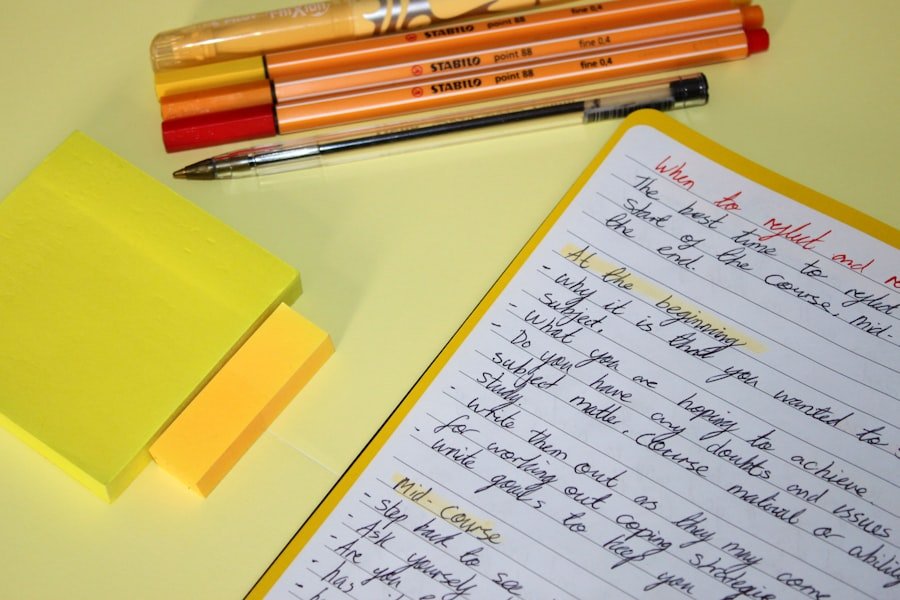Note-taking is a fundamental skill that plays a pivotal role in the academic success of college students. It serves as a bridge between passive listening and active learning, allowing students to engage with the material presented in lectures. When students take notes, they are not merely transcribing what the professor says; they are processing information, identifying key concepts, and synthesizing ideas.
This active engagement helps to reinforce memory retention and comprehension, making it easier for students to recall information during exams and discussions. Moreover, effective note-taking fosters critical thinking skills. As students distill complex information into concise notes, they learn to discern what is most important and relevant.
This skill is invaluable not only in academia but also in professional settings where the ability to summarize and communicate ideas clearly is essential. In a world inundated with information, the capacity to take organized and meaningful notes can set students apart, equipping them with tools that enhance their learning experience and prepare them for future challenges.
Different Note-Taking Methods and Techniques
There are several note-taking methods that cater to different learning preferences and lecture styles. One of the most popular techniques is the Cornell Method, which divides the page into three sections: cues, notes, and summary. In this format, students write their main notes in the largest section during the lecture, jot down keywords or questions in the cue column after class, and summarize the content at the bottom.
This structured approach not only organizes information but also encourages students to engage with their notes post-lecture, reinforcing their understanding. Another effective method is the Outline Method, which organizes information hierarchically. Students create main headings for major topics and use indents to denote subtopics and supporting details.
This technique is particularly useful for lectures that follow a clear structure, allowing students to visualize relationships between concepts. Additionally, the Mapping Method employs visual diagrams to represent information graphically. This method is beneficial for visual learners who grasp concepts better when they can see how ideas connect.
Each of these methods has its strengths, and students may find that a combination of techniques works best for their unique learning styles.
Tips for Organizing and Reviewing Your Notes

Organizing notes effectively is crucial for maximizing their utility during study sessions. One practical tip is to date each set of notes and label them with the course name and topic. This simple practice makes it easier to locate specific notes later on.
Additionally, using color coding can enhance organization; for instance, students might use one color for definitions, another for examples, and yet another for important concepts. This visual differentiation can aid memory retention by creating a more engaging study experience. Reviewing notes regularly is equally important.
Instead of waiting until exam time to revisit notes, students should schedule weekly review sessions. During these sessions, they can go over their notes, highlight key points, and create flashcards for important terms or concepts. This spaced repetition technique helps reinforce learning and ensures that information remains fresh in their minds.
Furthermore, discussing notes with peers can provide new insights and deepen understanding, as collaborative learning often leads to richer discussions and a more comprehensive grasp of the material.
How to Stay Engaged and Active During Lectures
| Strategies | Benefits |
|---|---|
| Active Listening | Improved understanding of the material |
| Asking Questions | Clarification and engagement with the content |
| Participating in Discussions | Enhanced critical thinking and communication skills |
| Taking Notes | Better retention of information |
| Engaging with Visual Aids | Enhanced comprehension and retention |
Staying engaged during lectures can be challenging, especially in large classrooms where distractions abound. One effective strategy is to actively participate by asking questions or contributing to discussions. Engaging with the material in real-time not only keeps attention focused but also enhances comprehension.
Students should also consider sitting near the front of the classroom; this positioning minimizes distractions and allows for better interaction with the instructor. Another way to maintain engagement is through active listening techniques. Students can practice summarizing what they hear in their own words or predicting what might come next based on the lecture’s flow.
This mental engagement keeps the brain active and helps solidify understanding. Additionally, taking breaks during long lectures—if permitted—can help reset focus. A brief moment to stretch or breathe deeply can rejuvenate attention spans and improve overall retention of information.
Using Technology to Enhance Note-Taking
In today’s digital age, technology offers numerous tools that can enhance the note-taking process. Applications like Microsoft OneNote or Evernote allow students to create organized digital notebooks that can be easily accessed from multiple devices. These platforms often include features such as tagging, searching, and multimedia integration, enabling students to incorporate images, audio recordings, or links directly into their notes.
This versatility can cater to various learning styles and preferences. Moreover, voice recording apps can be invaluable for students who struggle to keep up with fast-paced lectures. By recording lectures, students can focus on understanding the material in real-time without the pressure of writing everything down verbatim.
They can later review the recordings alongside their notes for a more comprehensive understanding of the content. However, it’s essential for students to ensure they have permission from instructors before recording lectures to respect privacy and institutional policies.
The Role of Note-Taking in Studying and Test Preparation

Note-taking is not just a tool for capturing information; it plays a critical role in studying and test preparation as well. Well-organized notes serve as a personalized study guide that reflects an individual’s understanding of the material. When preparing for exams, students can use their notes to create outlines or concept maps that highlight key themes and connections between topics.
This process not only aids in memorization but also encourages deeper engagement with the subject matter. Additionally, reviewing notes in conjunction with textbooks or other resources can enhance comprehension and retention. Students should aim to integrate their notes with supplementary materials by comparing different sources of information.
This cross-referencing helps solidify knowledge and provides a more rounded perspective on complex topics. Furthermore, practicing retrieval by quizzing oneself using notes can significantly improve recall during exams, making note-taking an integral part of effective study habits.
Note-Taking for Different Learning Styles
Recognizing that students have diverse learning styles is essential when discussing note-taking strategies. Visual learners may benefit from techniques such as mind mapping or using diagrams to represent information visually. These learners often find that seeing relationships between concepts helps them understand and remember material more effectively.
Incorporating colors, symbols, or images into their notes can further enhance retention. Auditory learners, on the other hand, may find that recording lectures or participating in group discussions aids their understanding. They might prefer summarizing spoken content rather than relying solely on written notes.
Kinesthetic learners often thrive when they engage physically with the material; thus, they might benefit from writing notes by hand rather than typing them out or using gestures while summarizing concepts aloud. By tailoring note-taking methods to individual learning styles, students can optimize their study practices and improve overall academic performance.
Common Mistakes to Avoid When Taking Notes
While note-taking is a valuable skill, there are common pitfalls that students should be aware of to maximize its effectiveness. One frequent mistake is attempting to write down everything verbatim instead of focusing on key points and concepts. This approach can lead to overwhelming amounts of information that are difficult to review later on.
Instead, students should practice summarizing ideas in their own words while capturing essential details. Another common error is neglecting to review or organize notes after lectures. Many students take notes diligently but fail to revisit them regularly or integrate them into their study routines.
This oversight can result in forgotten material and decreased retention over time. To combat this issue, students should establish a consistent review schedule that allows them to engage with their notes actively rather than passively storing them away until exam time. In conclusion, effective note-taking is an essential skill that significantly impacts academic success in college.
By understanding its importance, exploring various methods and techniques, organizing notes efficiently, staying engaged during lectures, leveraging technology, recognizing different learning styles, and avoiding common mistakes, students can enhance their learning experience and achieve their academic goals more effectively.
FAQs
What are effective note-taking methods for college students?
Effective note-taking methods for college students include using the Cornell method, outlining method, mapping method, and charting method. These methods help students organize and retain information from lectures and readings.
How can the Cornell method help with note-taking?
The Cornell method involves dividing your notes into three sections: a cue column, a notes column, and a summary section. This method helps students to actively engage with the material, organize their notes, and create a concise summary of the main points.
What is the outlining method of note-taking?
The outlining method involves creating a hierarchical structure of main ideas and supporting details. This method helps students to see the relationships between different concepts and organize information in a logical manner.
How does the mapping method work for note-taking?
The mapping method involves creating visual representations of the relationships between different concepts using diagrams, flowcharts, or mind maps. This method helps students to understand the connections between ideas and see the “big picture” of the material.
What is the charting method of note-taking?
The charting method involves creating tables or charts to compare and contrast different pieces of information. This method helps students to organize and categorize information, making it easier to review and study later.
Why is effective note-taking important for college students?
Effective note-taking is important for college students because it helps them to actively engage with the material, organize their thoughts, and retain information for exams and assignments. Good note-taking skills can also improve overall academic performance.



